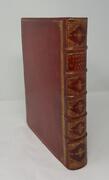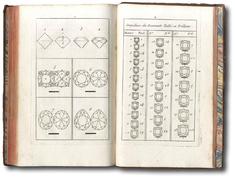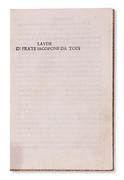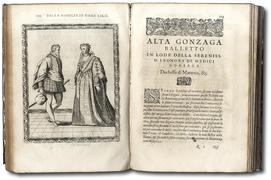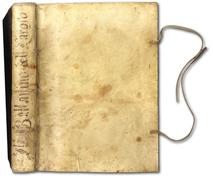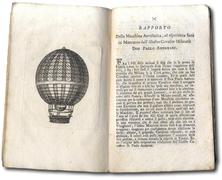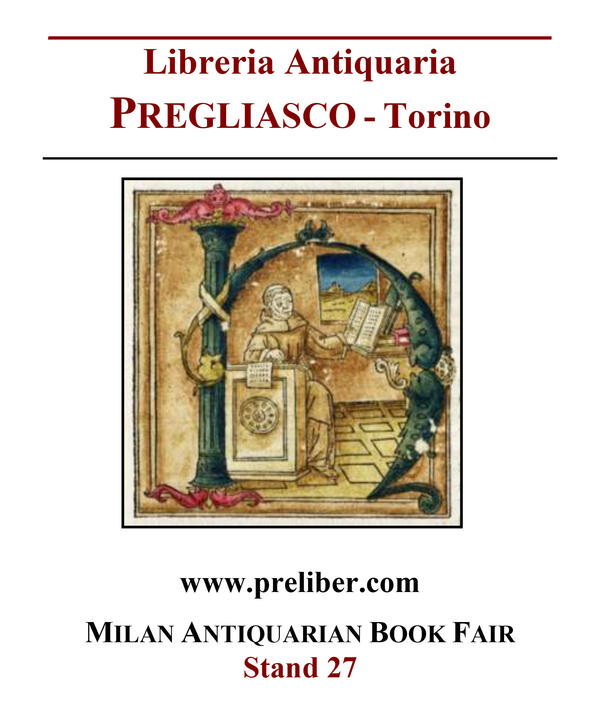
Octavo (184x117 mm), (2, including title), 19, (1), 8 pp., with 2 plates depicting the balloons of Montgolfier and Andreani. Strictly contemporary paper binding decorated with floral motifs. The first section contains an account of Montgolfier's French experience, while the second describes Andreani's flight at Moncucco on March 13. First and only edition of the description of the first hot air balloon flight in Italy. After a couple unsuccessful attempts, the first people to fly in Italy were Paolo Andreani and the brothers Carlo and Agostino Gerli, who had met at the beginning of 1783 when they managed to raise a small, empty balloon near Porta Venezia. The young count commissioned the three Gerli architects (the third, Giuseppe, would have remained on the ground) to build a balloon of about 23 meters in diameter (33 Milanese braccia). Few people attended the first flight outside of France – the fourth overall in history
– which took place on 25 February in the park of Villa Andreani in Moncucco (Brugherio). It was an astonishing event, as described by Agostino Gerli in his Opuscoli, published by Bodoni: “Il piacere grande che da noi si provava nell'osservare la sottoposta terra, l'impressione che in noi faceva il dominare da quell'altezza uno sterminato continente, ne rese estatici e rapiti. Nessuno potrà mai, per parole, descrivere la delizia di un aereo viaggio. L'entusiasmo era tale che si continuava ad alimentare il fuoco, fino a rimanere senza combustibile. ... Non può essere stata se non estrema la contentezza. Vedemmo col fatto smentite le dicerie, gli schiamazzi di coloro che dicevano il nostro un sogno, una temerarietà” (pag. 17).
Andreani planned a second flight for March 13, erecting a stage and inviting Emperor Joseph II in vain, as the latter thought it improper to witness the suicide of one of his subjects; according to Pietro Verri, he commissioned the Count of Wilzeck to bribe the Gerli brothers with a large sum of money, so that they would not help the imprudent count into flight. In any case, this time, in front of an enthusiastic crowd, the balloon reached a height of 1,200 meters, traveled east for five kilometers, and landed after 25 minutes near a farmhouse in Carugate. Four days later, on March 17, the Emperor claimed that "un volo la cui temerarietà può avere un fine tragico" was not "uno spettacolo degno di un virtuoso e benefico padre del suo Popolo" ("a flight whose recklessness may have resulted in a tragic end" was not "a show worthy of a virtuous and beneficent father of his people") and passed a law prohibiting the raising of balloons with a clear flame throughout the territory of Lombardy-Veneto: it was the first act of aeronautical legislation in history.A very rare booklet, recorded in only three European public libraries: two in Italy (Achille Bertarelli and the National Library of Naples), and one in France (Académie des sciences). As in the present copy, the copies in France and the Battarelli both have two plates, while the one in Naples is described as having three, possibly due to a cataloging error. Small stain on pp. 7-14, but an excellent, fresh copy.
our history
Lettere amorose di madonna Celia gentildonna romana scritte al suo amante. (Legato con:) BARGAGLI, Girolamo Dialogo de' giuochi che nelle vegghie sanesi si usano di fare. Del Materiale Intronato
2 works in 1 volume. Octavo, eighteenth-century hazelnut morocco binding, gilt border stylized with eagles and plant elements, "à la grotesque" spine with alabel. Containing: Clelia Romana, 70 ll., printer's device, historiated initials. Rare edition (found in only three Italian libraries) of this collection of love letters written by Celia, a Roman noblewoman, to her lover. The work was first published in 1562 and represents a rare example of female Renaissance literature, although some bibliographies cite Girolamo Parabosco as the probable author. - Bargagli, Girolamo, 288 pp. Printer's device on title page, dedication to Isabella de' Medici Orsina, Duchess of Bracciano, printer's address to the reader and alphabetical index of the games discussed in the work. It was first published in Siena in 1572 and was subsequently reprinted several times. The dialogue is the last documentation of Bargagli's youthful interests, and was composed as a sign of gratitude to the Accademia degli Intronati as he moved away, as he himself states in the introduction, “da, suoi piacevoli studi” (“from his pleasant studies”). The work consists of a Platonic dialogue between some young Intronati gathered around Marcantonio Piccolomini, known as “Il Sodo”. It opens with a fundamental distinction between different types of games and is followed by a catalogue with short descriptions. The second part focuses on the ideal academic, the invention of companies, and storytelling as a form of entertainment. Damp stain to lower blank margin of first four leaves, but an otherwise excellent copy.

Octavo (184x117 mm), (2, including title), 19, (1), 8 pp., with 2 plates depicting the balloons of Montgolfier and Andreani. Strictly contemporary paper binding decorated with floral motifs. The first section contains an account of Montgolfier's French experience, while the second describes Andreani's flight at Moncucco on March 13. First and only edition of the description of the first hot air balloon flight in Italy. After a couple unsuccessful attempts, the first people to fly in Italy were Paolo Andreani and the brothers Carlo and Agostino Gerli, who had met at the beginning of 1783 when they managed to raise a small, empty balloon near Porta Venezia. The young count commissioned the three Gerli architects (the third, Giuseppe, would have remained on the ground) to build a balloon of about 23 meters in diameter (33 Milanese braccia). Few people attended the first flight outside of France – the fourth overall in history
– which took place on 25 February in the park of Villa Andreani in Moncucco (Brugherio). It was an astonishing event, as described by Agostino Gerli in his Opuscoli, published by Bodoni: “Il piacere grande che da noi si provava nell'osservare la sottoposta terra, l'impressione che in noi faceva il dominare da quell'altezza uno sterminato continente, ne rese estatici e rapiti. Nessuno potrà mai, per parole, descrivere la delizia di un aereo viaggio. L'entusiasmo era tale che si continuava ad alimentare il fuoco, fino a rimanere senza combustibile. ... Non può essere stata se non estrema la contentezza. Vedemmo col fatto smentite le dicerie, gli schiamazzi di coloro che dicevano il nostro un sogno, una temerarietà” (pag. 17).
Andreani planned a second flight for March 13, erecting a stage and inviting Emperor Joseph II in vain, as the latter thought it improper to witness the suicide of one of his subjects; according to Pietro Verri, he commissioned the Count of Wilzeck to bribe the Gerli brothers with a large sum of money, so that they would not help the imprudent count into flight. In any case, this time, in front of an enthusiastic crowd, the balloon reached a height of 1,200 meters, traveled east for five kilometers, and landed after 25 minutes near a farmhouse in Carugate. Four days later, on March 17, the Emperor claimed that "un volo la cui temerarietà può avere un fine tragico" was not "uno spettacolo degno di un virtuoso e benefico padre del suo Popolo" ("a flight whose recklessness may have resulted in a tragic end" was not "a show worthy of a virtuous and beneficent father of his people") and passed a law prohibiting the raising of balloons with a clear flame throughout the territory of Lombardy-Veneto: it was the first act of aeronautical legislation in history.A very rare booklet, recorded in only three European public libraries: two in Italy (Achille Bertarelli and the National Library of Naples), and one in France (Académie des sciences). As in the present copy, the copies in France and the Battarelli both have two plates, while the one in Naples is described as having three, possibly due to a cataloging error. Small stain on pp. 7-14, but an excellent, fresh copy.
our history
Octavo (184x117 mm), (2, including title), 19, (1), 8 pp., with 2 plates depicting the balloons of Montgolfier and Andreani. Strictly contemporary paper binding decorated with floral motifs. The first section contains an account of Montgolfier's French experience, while the second describes Andreani's flight at Moncucco on March 13. First and only edition of the description of the first hot air balloon flight in Italy. After a couple unsuccessful attempts, the first people to fly in Italy were Paolo Andreani and the brothers Carlo and Agostino Gerli, who had met at the beginning of 1783 when they managed to raise a small, empty balloon near Porta Venezia. The young count commissioned the three Gerli architects (the third, Giuseppe, would have remained on the ground) to build a balloon of about 23 meters in diameter (33 Milanese braccia). Few people attended the first flight outside of France – the fourth overall in history
– which took place on 25 February in the park of Villa Andreani in Moncucco (Brugherio). It was an astonishing event, as described by Agostino Gerli in his Opuscoli, published by Bodoni: “Il piacere grande che da noi si provava nell'osservare la sottoposta terra, l'impressione che in noi faceva il dominare da quell'altezza uno sterminato continente, ne rese estatici e rapiti. Nessuno potrà mai, per parole, descrivere la delizia di un aereo viaggio. L'entusiasmo era tale che si continuava ad alimentare il fuoco, fino a rimanere senza combustibile. ... Non può essere stata se non estrema la contentezza. Vedemmo col fatto smentite le dicerie, gli schiamazzi di coloro che dicevano il nostro un sogno, una temerarietà” (pag. 17).
Andreani planned a second flight for March 13, erecting a stage and inviting Emperor Joseph II in vain, as the latter thought it improper to witness the suicide of one of his subjects; according to Pietro Verri, he commissioned the Count of Wilzeck to bribe the Gerli brothers with a large sum of money, so that they would not help the imprudent count into flight. In any case, this time, in front of an enthusiastic crowd, the balloon reached a height of 1,200 meters, traveled east for five kilometers, and landed after 25 minutes near a farmhouse in Carugate. Four days later, on March 17, the Emperor claimed that "un volo la cui temerarietà può avere un fine tragico" was not "uno spettacolo degno di un virtuoso e benefico padre del suo Popolo" ("a flight whose recklessness may have resulted in a tragic end" was not "a show worthy of a virtuous and beneficent father of his people") and passed a law prohibiting the raising of balloons with a clear flame throughout the territory of Lombardy-Veneto: it was the first act of aeronautical legislation in history.A very rare booklet, recorded in only three European public libraries: two in Italy (Achille Bertarelli and the National Library of Naples), and one in France (Académie des sciences). As in the present copy, the copies in France and the Battarelli both have two plates, while the one in Naples is described as having three, possibly due to a cataloging error. Small stain on pp. 7-14, but an excellent, fresh copy.
featured books

small 8vo (123x82 mm), pp. 352, (16, of which the final blank is present), contemporary limp vellum binding. Printer's device on the title page, decorative woodcut initials in the text.
A rare second edition of the French translation. More's Utopia is a narrative describing an ideal society developed on an imaginary island. It expresses the Renaissance dream of a peaceful society where culture regulates the lives of people.
Already in its fourth edition by 1519, it was translated into German by Claudio Cantiuncula (1524), into Florentine by Ortensio Lando (1548), into French by Jean Le Blond (1550), and into English only in 1551 (by Ralph Robinson). The first French edition appeared with the title "La description de l'isle d'Utopie ou est compris le miroer des republicques du monde, & l'exemplaire de vie heureuse .." and was published in Paris by Charles L'Angelier.
In the two centuries following the publication of More's Utopia, as many as four French translations were produced; these were all translations of the original Latin text, mostly from the 1518 Basel edition rather than the 1516 Louvain version. The present translation by Jean Le Blond was edited by the poet and humanist Barthélemy Aneau (c. 1510–1561), who provides an introduction and additional notes in this second edition, possibly contributing to its greater rarity relative to the first (while 11 copies of the first edition are known, only 4 of the second edition have been found in public libraries).
Aneau was born in Bourges but later moved to Lyon where he became a professor of rhetoric at the Collège de la Trinité, and then served as its principal; he was killed in a riot in 1561 as he was suspected of Protestantism, and it was believed that his college provided an unorthodox education.
A beautiful copy of this rare work, on the final blank a contemporary hand has written notes on the work in Spanish, some pen sketches.
in-8, ( mm 200 x 125) pp.(8), XXXV, 104, con 10 bellissime tavole incise in fine raffiguranti "Grandeurs des diamants taillés en brillants"; testatina incisa sulla pagina della dedicatoria; legatura coeva in pieno vitello , titolo in oro al dorso, finemente e fittamente ornato in oro con motivo a diamanti. Prima edizione francese del "primo libro libro inglese che descrive come si possono valorizzare i diamanti e le perle in base alla grandezza, o al peso, e le varie modalità di taglio". La traduzione venne fatta da Chapotin St. Laurent sulla seconda edizione inglese del 1751; redatto da un gioielliere inglese questo trattato restò per più di 100 anni punto di riferimento imprescindibile per la valutazione dei diamanti. Precede il testo dedica al Principe di Condé, l'opera è divisa in 28 capitoli e tratta della produzione, grandezza, stima, del taglio a brillante e a rosa, della purezza dei diamanti e di analoghi argomenti per le perle. Esemplare estremamente fresco; al contropiatto ex libris J.A. Freilich.
Octavo (184x117 mm), (2, including title), 19, (1), 8 pp., with 2 plates depicting the balloons of Montgolfier and Andreani. Strictly contemporary paper binding decorated with floral motifs. The first section contains an account of Montgolfier's French experience, while the second describes Andreani's flight at Moncucco on March 13. First and only edition of the description of the first hot air balloon flight in Italy. After a couple unsuccessful attempts, the first people to fly in Italy were Paolo Andreani and the brothers Carlo and Agostino Gerli, who had met at the beginning of 1783 when they managed to raise a small, empty balloon near Porta Venezia. The young count commissioned the three Gerli architects (the third, Giuseppe, would have remained on the ground) to build a balloon of about 23 meters in diameter (33 Milanese braccia). Few people attended the first flight outside of France – the fourth overall in history
– which took place on 25 February in the park of Villa Andreani in Moncucco (Brugherio). It was an astonishing event, as described by Agostino Gerli in his Opuscoli, published by Bodoni: “Il piacere grande che da noi si provava nell'osservare la sottoposta terra, l'impressione che in noi faceva il dominare da quell'altezza uno sterminato continente, ne rese estatici e rapiti. Nessuno potrà mai, per parole, descrivere la delizia di un aereo viaggio. L'entusiasmo era tale che si continuava ad alimentare il fuoco, fino a rimanere senza combustibile. ... Non può essere stata se non estrema la contentezza. Vedemmo col fatto smentite le dicerie, gli schiamazzi di coloro che dicevano il nostro un sogno, una temerarietà” (pag. 17).
Andreani planned a second flight for March 13, erecting a stage and inviting Emperor Joseph II in vain, as the latter thought it improper to witness the suicide of one of his subjects; according to Pietro Verri, he commissioned the Count of Wilzeck to bribe the Gerli brothers with a large sum of money, so that they would not help the imprudent count into flight. In any case, this time, in front of an enthusiastic crowd, the balloon reached a height of 1,200 meters, traveled east for five kilometers, and landed after 25 minutes near a farmhouse in Carugate. Four days later, on March 17, the Emperor claimed that "un volo la cui temerarietà può avere un fine tragico" was not "uno spettacolo degno di un virtuoso e benefico padre del suo Popolo" ("a flight whose recklessness may have resulted in a tragic end" was not "a show worthy of a virtuous and beneficent father of his people") and passed a law prohibiting the raising of balloons with a clear flame throughout the territory of Lombardy-Veneto: it was the first act of aeronautical legislation in history.A very rare booklet, recorded in only three European public libraries: two in Italy (Achille Bertarelli and the National Library of Naples), and one in France (Académie des sciences). As in the present copy, the copies in France and the Battarelli both have two plates, while the one in Naples is described as having three, possibly due to a cataloging error. Small stain on pp. 7-14, but an excellent, fresh copy.
Octavo (mm 172x110), pp. (32, the last leaf blank), 136, (24), early XIXth century calf, fillets and super-libros of Camille Aboussouan gilt on the front cover, spine and edges gilt. Coat-of-arms of Jerusalem on the title-page, a long dedication to Ernesto, Archbishop of Cologne and poetic compositions in praise of the author and of the work. Second edition in Latin (the first appeared in 1585) of this rare work that in 270 chapters describes in detail the doors, streets and main buildings of the Holy City, with a special attention to the Temple, and the nearby places as they were at the time of Christ. The text also includes brief historical notes on the life, passion and death of Christ and other Saints.At the end, 36 sources used by the author are listed. Chr. Adrichem (Delft 1533 - Cologne 1585) dedicated his life to the study of the Holy Land: he also published other important works, including the ''Theatrum Terrae Sanctae''. A fresh copy. Adams A-189. Index Aureliensis 100.711.
"The first appearance in print of the "Cantico delle Creature"
Folio, (mm 273x198), ff. (4), CCLVI ff., very fine 18th-century red morocco, gilt on spine, border, and corners of the covers in gilt. On title-page a large border and a woodcut depicting Saint Francis Receiving the Stigmata. On verso, a magnificent full-page woodcut "Arbor conformitatum" with black background showing the "tree of conformities", on which Christ is crucified, St Francis kneeling at foot of the tree. First Edition of this remarkable and controversial book, which expounds on the "conformities" between the life of St. Francis of Assisi and the life of Jesus Christ. It was disparaged and mocked by the protestants as "the Koran of the Franciscans". By side with fantastic legends, visions, and prophecies, it is of great value and importance for the history of the Franciscans. This edition is also famous because it includes the first appearance in print of the "Cantico delle Creature" (from the verso of l. CCII to the recto of l. CCIII); also known as the Cantico di Frate Sole, it is the earliest known poetic text in Italian, the author's writing dating back to two years before the death of St. Francis (1226). Some leaves restored in the right margin, the woodcut on the verso of title-page slightly trimmed.
4°, (mm 227 x163) 149 [i.e. 147, pp. 69-72 omitted], [1] pages, without blank leaf M2. 3engraved folding plates (of 5?) by Greuter. Recase in a nice binding with rich decoration including the Medici coat-of-arms; spine renewed with old gilt calf. Second edition of Rinuccini's description of the festivities celebrating the marriage of Cosimo II de' Medici, Grand Duke of Tuscany toMaria Maddalena of Austria. This edition is expanded from the first edition to include texts of the musical dialogues by Cini entitled L'Argonauta and La notte d'amore. Vinet 608 (calling for 5 plates). Woodcut coat of arms of the Medici and Habsburg families on the title-page. One of the most famous festival books of the late Renaissance.Florence witnessed an unprecedented series of events: plays, musical intermezzi, giostre, horse ballets, a triumphal procession, banquet, and even a naval battle or naumachia on the Arno river. Camillo Rinuccini narrated all of these magnificent events, and his Descrizione enjoyed wide and immediate success. Especially noteworthy is Lorenzo Franceschi's Ballo et Giostra de' venti (fols. N1r-N4r), a poem in octaves describing a horse ballet illustrated with a fine thirty-two-point compass rose or wind rose (fol. N4r), which was also issued separately from the Giunti press.
Watanabe-O' Kelly calls for two plates, but a few copies containing five plates are recorded.“Vinet [...] conjectures that the plates were published separately, each having been dedicated to a separate person [...] in similar cases the author, publisher or the buyer might bring the plates to the printer for inclusion in the bound book”
2 works in 1 volume. Octavo, eighteenth-century hazelnut morocco binding, gilt border stylized with eagles and plant elements, "à la grotesque" spine with alabel. Containing: Clelia Romana, 70 ll., printer's device, historiated initials. Rare edition (found in only three Italian libraries) of this collection of love letters written by Celia, a Roman noblewoman, to her lover. The work was first published in 1562 and represents a rare example of female Renaissance literature, although some bibliographies cite Girolamo Parabosco as the probable author. - Bargagli, Girolamo, 288 pp. Printer's device on title page, dedication to Isabella de' Medici Orsina, Duchess of Bracciano, printer's address to the reader and alphabetical index of the games discussed in the work. It was first published in Siena in 1572 and was subsequently reprinted several times. The dialogue is the last documentation of Bargagli's youthful interests, and was composed as a sign of gratitude to the Accademia degli Intronati as he moved away, as he himself states in the introduction, “da, suoi piacevoli studi” (“from his pleasant studies”). The work consists of a Platonic dialogue between some young Intronati gathered around Marcantonio Piccolomini, known as “Il Sodo”. It opens with a fundamental distinction between different types of games and is followed by a catalogue with short descriptions. The second part focuses on the ideal academic, the invention of companies, and storytelling as a form of entertainment. Damp stain to lower blank margin of first four leaves, but an otherwise excellent copy.
Small 4to, pp. (4), Medici's coat of arms on the title, ornated initial, in nice XVII century gilt paper. First edition of this rare provision of the city of Florence forbidding the use of tinsel (Italian “orpello”; an alloy of copper, tin, and zinc, similar to gold), cut and spun like gold leaf. The use of tinsel was negatively affecting the work of the famous Florentine goldsmiths and this provision was announced to protect their excellence. However, five Florentine monasteries are exempted (S. Jacopo, S. Francesco, Monte Domini, d' Annalena, and the monastery of the Nunziatina beyond the Arno) but for the sole purpose of making flowers and garlands. The document is signed in print "Francesco Guidalotti banditore questo dì 9 di Febbraio 1597". Of great interest for Florentine guilds and handicrafts, this rare booklet is preserved in a precious gilt wrappers covered with thin copper or brass foil (traces of oxidation), in clear reference to its subject matter.
Quarto (236x170 mm), ll. (8 including title page with printer's device, dedication to and sonnets for Bianca Cappello, dedication to the readers, sonnets in praise of the author and a portrait of Caroso “d'anni xxxxvi”) ll. 16 (with the Trattato Primo divided into 54 Regole), 184 (the Trattato Secondo), (4 with the Indice).
and titolo con impresa editoriale, dediche e Sonetti a Bianca Cappello, dedica ai Lettori, Sonetti in lode all'autore e ritratto del Caroso “d'anni xxxxvi”), ff. 16 con il Trattato Primo diviso in 54 Regole, 184 Trattato Secondo, (4 with Indice), contemporary semi-limp vellum, the calligraphed title along the length of the spine, leather laces, in an elegant half-leather case. Illustrated with a portrait of the author and 22 copper engravings by Giacomo Franco showing pairs of dancers in magnificent period dress. First edition, dedicated to Bianca Cappello. The first book ends on the verso of l. 16 with a page of “Avertimento alle donne” (“warnings to women”); this is followed by a second title page and text describing 49 dances, the first two dedicated to Bianca Cappello. A very elegant work on the most important dances at the Italian, French and Spanish courts of the sixteenth century; also includes musical arias, with lute notation. Provenance: engraved ex-libris of Eugenio di Savoia-Carignano (1816-88) on the pastedown, e nell'astuccio the ex-libris of Mario Serandrei. A clean, authentic copy, damp stain on the upper inside corner of the quire containing the index. Carefully erased signature on title page, some glosses and underlining only to the Regole. Colas 532. Nagriel 43. Derra de Moroda 527
First edition, dedicated to Bianca Capello, of the most important Italian writing about the Sixteenth-century dance. The first part describes fifty-five rules for the proper execution of dance steps, while the second part, more extensive, browsing seventy-six varieties of different dances ( ballets and cascades), each one is accompanied by a poem in praise of a lady and by musical notes for lute. All the dances are designed for one or more pairs of dancers. The figures, that shows the position of the dancers at the beginning of each dance, constitute an amazing iconographic source not only for the history of dance but also for the history of the costume Caroso was the ultimate interpreter of Italian dance style of the late Renaissance, particularly in its opposition to the French dance noble, which just then beginning to spread across Europe. Compared to group dances ( mostly anonymous) of the French style, the Italian style expected that the various ballets, real "danze d'arte", were composed by dance teachers for only one couple (or, less often, for a trio). Each ballet was equipped with original music, often performed by only stringed instruments groups (lute, bass-viol, viola da braccio), without percussion. Born in Sermoneta, Fabrizio Caroso started his career in Rome, where lived almost all his life, under the protection of Felice Maria Orsini Caetani, Duchess of Sermoneta. Wandering from 1554 all the grades of a brilliant professional career (dancer, theorist and "inventore di scene", dance teacher, instrumentalist, composer), Caroso entrusted his works (Il Ballarino of 1581 and Nobiltà di dame in 1600) the most appropriate key to the interpretation of the "bel danzar che con virtù s'acquista". Refined and competent theorist, as well as artist directly involved in practice of dance, Caroso celebrated the figure of the dancer-courtesan highly trained (in the education, in the culture and in the 'nobil vivere') and exalted the aristocratic matrix ( "da sala") of dance, to be performed with great precision and complete mastery of the theoretical precepts.
Folio (360 x 320 mm), quarter leather binding with sanded aluminium sides and in a felt-lined aluminium box. First and only edition, printed on 0,25 millimetres thick aluminium in only 50 copies, plus 10 hors commerce. This copy bears the number 13 and is signed by the artist in pencil on aluminium. A perfect copy, complete with its announcing leaflet.
This artist book includes 5 abstract representations of the Brooklyn Bridge painted on sanded aluminium pages.
The painted acrylic images and silk-screened text of this volume rest on sanded aluminium pages that have been attached to a traditional binding structure. The book contains assemblages of metal wire and sand that relate to the structure and textures of the bridge. On each page a variety of materials are organized and manipulated to make an astonishingly original work of art.
The Brooklyn Bridge was the first Steel Cable Bridge and the longest suspension bridge in the world. It has, since its opening in 1883, inspired many writers and artists. Glaister has created a book with materials that are not what one would expect, but are fully consistent with the topic of the book.
A quire of 4 leaves printed in 1685 by Giacomo Monti, containing an instance to the Senate by two anonymous artists who ask an exemption from taxes, as painters are not craftsmen or decorators: paintings are not created by the colours used, but by the artist's genius. “Certo che chi acquista una testa diremmo del gran Raffaele, o del Correggio, un ritratto di Tiziano, non compra...quelle pochissime tenteche l'han colorito..., ma il magistero di quella operazione, preziosa per l'eccellenza della forma...”. This unknown and very important instance ends with the hope that the painters from Bologna will take profit of the exemption, as already happens in Rome, Florence, Genoa, Venice and Milan and in various states of Europe. (In nice contemporary marbled boards; traces of old folding on the boards and on the leaves, restored on the first leaf; otherwise in good condition, uncut).
Folio (360 x 320 mm), quarter leather binding with sanded aluminium sides and in a felt-lined aluminium box. First and only edition, printed on 0,25 millimetres thick aluminium in only 50 copies, plus 10 hors commerce. This copy bears the number 13 and is signed by the artist in pencil on aluminium. A perfect copy, complete with its announcing leaflet.
This artist book includes 5 abstract representations of the Brooklyn Bridge painted on sanded aluminium pages.
The painted acrylic images and silk-screened text of this volume rest on sanded aluminium pages that have been attached to a traditional binding structure. The book contains assemblages of metal wire and sand that relate to the structure and textures of the bridge. On each page a variety of materials are organized and manipulated to make an astonishingly original work of art.
The Brooklyn Bridge was the first Steel Cable Bridge and the longest suspension bridge in the world. It has, since its opening in 1883, inspired many writers and artists. Glaister has created a book with materials that are not what one would expect, but are fully consistent with the topic of the book.
Small 4to, pp. (4), Medici's coat of arms on the title, ornated initial, in nice XVII century gilt paper. First edition of this rare provision of the city of Florence forbidding the use of tinsel (Italian “orpello”; an alloy of copper, tin, and zinc, similar to gold), cut and spun like gold leaf. The use of tinsel was negatively affecting the work of the famous Florentine goldsmiths and this provision was announced to protect their excellence. However, five Florentine monasteries are exempted (S. Jacopo, S. Francesco, Monte Domini, d' Annalena, and the monastery of the Nunziatina beyond the Arno) but for the sole purpose of making flowers and garlands. The document is signed in print "Francesco Guidalotti banditore questo dì 9 di Febbraio 1597". Of great interest for Florentine guilds and handicrafts, this rare booklet is preserved in a precious gilt wrappers covered with thin copper or brass foil (traces of oxidation), in clear reference to its subject matter.
4°, (mm 227 x163) 149 [i.e. 147, pp. 69-72 omitted], [1] pages, without blank leaf M2. 3engraved folding plates (of 5?) by Greuter. Recase in a nice binding with rich decoration including the Medici coat-of-arms; spine renewed with old gilt calf. Second edition of Rinuccini's description of the festivities celebrating the marriage of Cosimo II de' Medici, Grand Duke of Tuscany toMaria Maddalena of Austria. This edition is expanded from the first edition to include texts of the musical dialogues by Cini entitled L'Argonauta and La notte d'amore. Vinet 608 (calling for 5 plates). Woodcut coat of arms of the Medici and Habsburg families on the title-page. One of the most famous festival books of the late Renaissance.Florence witnessed an unprecedented series of events: plays, musical intermezzi, giostre, horse ballets, a triumphal procession, banquet, and even a naval battle or naumachia on the Arno river. Camillo Rinuccini narrated all of these magnificent events, and his Descrizione enjoyed wide and immediate success. Especially noteworthy is Lorenzo Franceschi's Ballo et Giostra de' venti (fols. N1r-N4r), a poem in octaves describing a horse ballet illustrated with a fine thirty-two-point compass rose or wind rose (fol. N4r), which was also issued separately from the Giunti press.
Watanabe-O' Kelly calls for two plates, but a few copies containing five plates are recorded.“Vinet [...] conjectures that the plates were published separately, each having been dedicated to a separate person [...] in similar cases the author, publisher or the buyer might bring the plates to the printer for inclusion in the bound book”
Quarto (12 ll.), 370 pp., (3 ll.), contemporary limp vellum binding, spine with the gilt handwritten title. Title page with an elaborate architectural frame, oval portraits of Ranuccio Farnese and Margherita Aldobrandina, and a portrait of Caroso “d'anni lxxiiii”. 35 full-page engravings of dancing couples by Giacomo Franco. First edition of the second state of Il Ballarino, dedicated to the Farnese family, greatly expanded by Caroso himself and including descriptions of 78 dances. A very nice, fresh copy with wide margins. “The work sets down in great detail the manner of execution of the dances fashionable at the courts of, and during the Renaissance. Herein are described minuets, gaillardes, caprioles, canaries, pavanes etc. together with their airs, accompanied by musical notations for the lute. The engravings (some of them repeated) are a full-length representation of both ladies and gentlemen and the costume of the epoch is rendered with a valuable wealth of detail”




